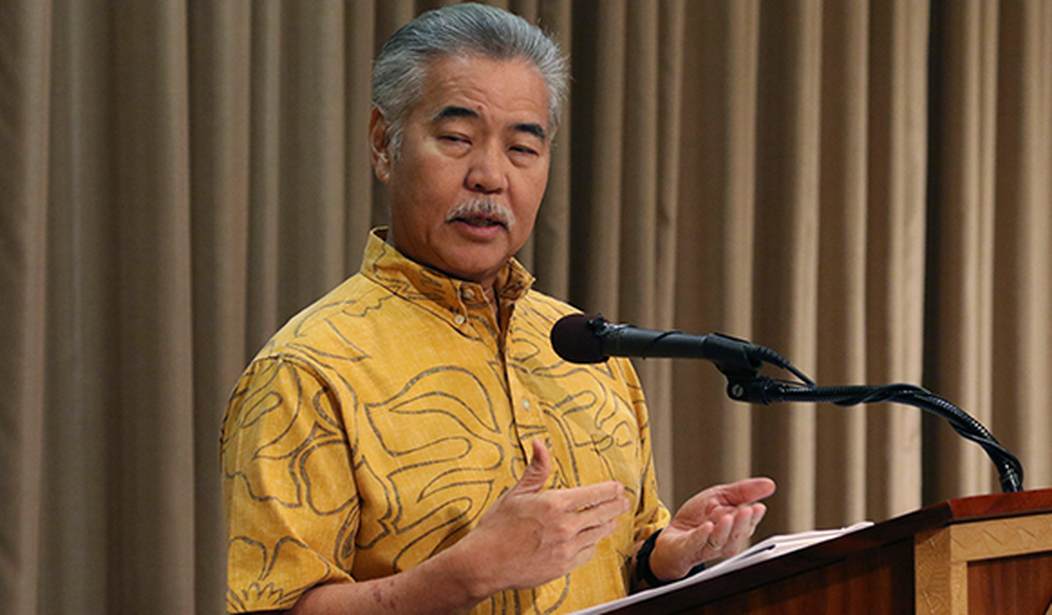Oh, you can still go to Hawaii, but … they’d prefer you stay home. Governor David Ige (D) held a press conference late yesterday to discourage tourists during their new wave of Delta-variant COVID-19. The governor pledged to work with airlines, hotels, and other businesses to put off planned and paid-for vacations for a more propitious time … like late October:
While the governor’s announcement does not prohibit travelers from visiting Hawaii, Ige (D) said at a news conference that he is working with airlines, hotels and other tourism-related businesses to “do what they could” to curb tourism to the state except for people traveling for essential business. Restaurant capacity has been restricted, and access to rental cars is limited.
The governor urged travelers to curb their visits to Hawaii while the state’s hospitals are at capacity due to the highly transmissible delta variant. While nearly 55 percent of the state’s eligible population is fully vaccinated — a rate higher than the national average — the delta variant in Hawaii, as it has elsewhere, has pushed up hospitalizations.
“Now is not the time to visit the islands,” he said at a news conference Monday. “It’s a risky time to be traveling right now.” Ige told the Honolulu Star-Advertiser, “I think it’s important that we reduce the number of visitors coming here to the islands.”
Ige isn’t kidding. With much of the focus on new-case waves in the Southeast, Hawaii has had its biggest spike of the pandemic — by far:

And while deaths remain close to zero, the island’s hospitals are running at their max or beyond. Again, this appears to be a pandemic high for the Aloha State:

Those are grim numbers indeed, especially given Hawaii’s status as an archipelago of islands. It’s not as easy to shift patients around to open resources as it is in a ground-contiguous state. The logistics alone are challenging for a sharp spike in hospital demand.
Is this a case of low vaccination rates leading to bad outcomes? Not for Hawaii residents, anyway. The state ranks 10th among all states and territories for vaccination rates, with 124K injected doses per 100K residents. (Mississippi, the state with the worst vaccination rate, has ~80K per 100K.) Hawaii ranks even better at the rate of adult vaccinations — eighth, at 148K per 100K residents.
Small wonder, then, that Ige wants to keep the tourists out for a while until the hospitalization curve drops back down to a manageable level. Unfortunately, the CDC’s recommendations apparently don’t allow him to shut travel down as Ige did last year:
The state, however, is not retightening its entry requirements. Hawaii previously allowed for travelers to present a negative coronavirus test to bypass the state’s strict quarantine, and that requirement went away last month for vaccinated travelers. But since the Centers for Disease Control and Prevention has said domestic travel is safe for vaccinated people, Ige told reporters that reinstituting the safety standard for those coming into Hawaii would be difficult.
Ige’s problem is that travel is safe for vaccinated people, but not all travelers are vaccinated. And tourism is safe for all vaccinated Hawaii residents, but not all Hawaii residents are fully vaccinated either. Thus we get the curves seen at the moment, although thankfully the death rate in Hawaii hasn’t picked up steam — yet.
The same cannot be said for the US as a whole:

Our seven-day average of daily COVID-19 deaths are at the level from mid-March, when the supply of vaccines was still somewhat limited. That’s not been the case for months, however, and the lack of uptake is still a concern. That has changed over the past month too, but not as fast as people may have hoped. The daily average is now 736K, about the same level as early June.
As Allahpundit pointed out, this last graph points out a major problem for Joe Biden and his “mission accomplished” rhetoric in late June. Deaths are ticking up again, his team isn’t doing well at encouraging vaccinations, and now we have a very blue state suffering a big hospitalization wave and encouraging people to keep out. All sorts of narratives are getting crossed with this summer wave.
Except one, that is — get vaccinated. The quicker we get everyone vaccinated and/or immune, the quicker we can manage COVID-19 as a seasonal viral issue rather than a public-health emergency. As it stands now, the lack of enough immunity in the “herd” makes fatal outcomes more likely, and crowds out others from accessing hospital and health-care resources.








Join the conversation as a VIP Member